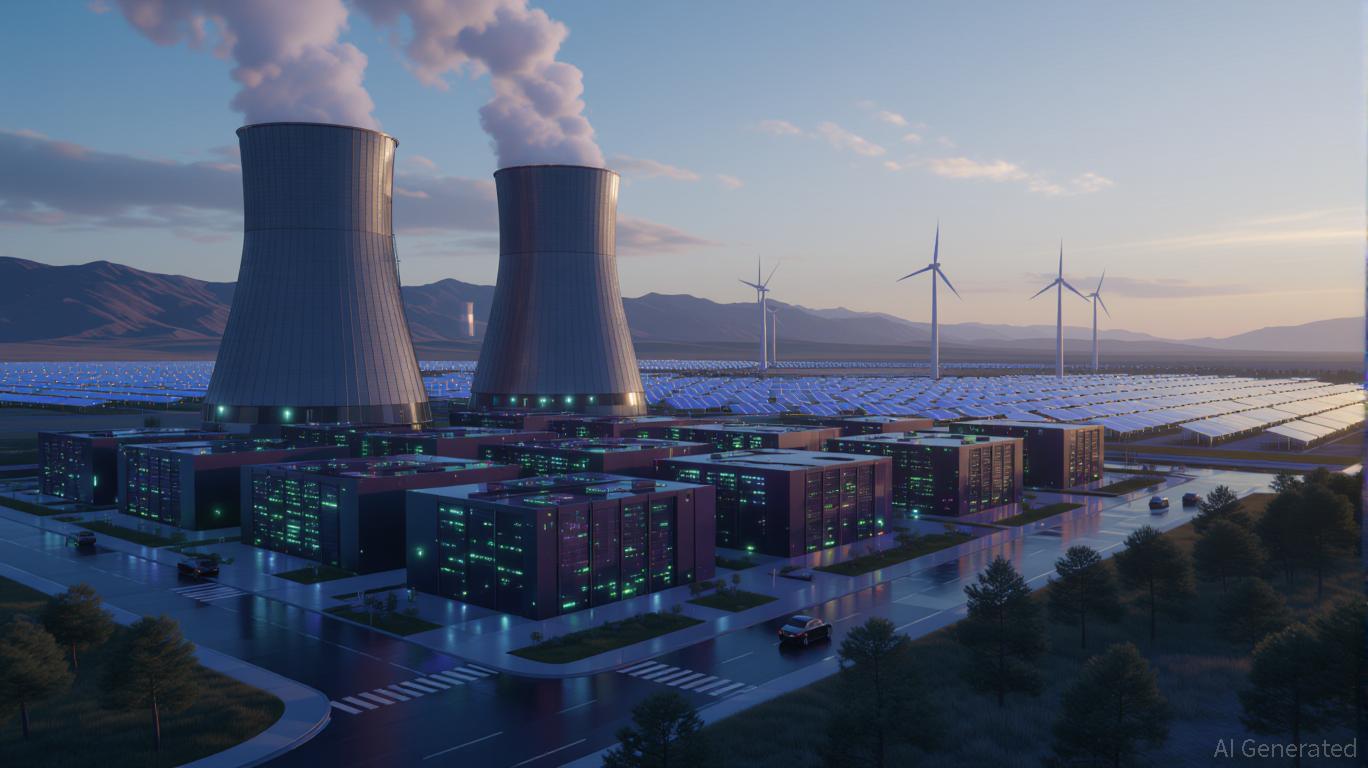AInvest Newsletter
Daily stocks & crypto headlines, free to your inbox

In 2025,
has embarked on a bold redefinition of its role in the artificial intelligence (AI) landscape. The company's Manhattan-sized data center projects, gigawatt-scale computing clusters, and a $14 billion investment in AI talent signal a strategic shift from a social media platform to a foundational player in the global AI infrastructure race. This move is not just a bet on technology—it is a reimagining of how capital is allocated in the 21st century, where energy, real estate, and compute power converge to determine competitive advantage. For investors, the implications are profound: Meta's infrastructure push is reshaping the dynamics of tech and cloud stocks, creating both opportunities and risks for those who understand the new rules of the game.Meta's AI infrastructure strategy is defined by its willingness to prioritize scale and speed over traditional efficiency. The Prometheus and Hyperion data centers, consuming over 5 gigawatts of power combined, are emblematic of this approach. These facilities are not just large—they are built to be fast. By deploying tented structures, pre-fabricated power modules, and on-site natural gas generation, Meta is bypassing the bureaucratic and physical constraints that have historically slowed data center construction. This is a departure from the incrementalism of the past decade, where cloud providers like
and focused on optimizing existing infrastructure.The financial commitment is staggering. Meta's $64–72 billion AI investment in 2025—second only to Amazon's $100 billion—reflects a willingness to spend at the margin where others hesitate. This is not just about building better models; it is about controlling the physical layer of AI. The company's Superintelligence Labs, staffed with elite researchers and backed by industry-leading compute power per capita, further underscore its intent to dominate the innovation pipeline.
For investors, this raises a critical question: Is Meta's capital allocation model sustainable, or is it a race to the bottom in a sector where returns are increasingly tied to scale rather than margins? The answer lies in the interplay between infrastructure costs and the network effects of AI. If Meta succeeds in democratizing access to its Llama models via partnerships with AWS and startups, it could create a self-reinforcing ecosystem that rivals even the mobile operating system duopoly of iOS and Android.
The rise of infrastructure-led AI is upending the traditional cloud computing model. For years, AWS, Azure, and Google Cloud have operated as middlemen, leasing compute resources to developers and enterprises. But Meta's collaboration with AWS—offering startups $200,000 in cloud credits and six months of technical support for Llama-based applications—signals a new era of vertical integration. Cloud providers are no longer just utilities; they are now platforms for AI innovation, with Meta leveraging AWS's infrastructure to expand its own ecosystem.
This partnership is a double-edged sword for cloud providers. On one hand, it accelerates AWS's ability to offer AI-ready infrastructure, potentially boosting demand for its GPU-optimized instances. On the other, it risks making AWS a dependency for Meta's open-source ambitions, reducing AWS's pricing power in the long run. The same dynamic is playing out with Google Cloud, which has partnered with OpenAI to deploy models on its TPU architecture.
For investors, the key takeaway is that cloud stocks are no longer homogeneous. Those with strong AI infrastructure capabilities—like AWS's Trainium chips or Google's TPUs—will outperform, while those lacking the capacity to support large-scale AI workloads may struggle. The rise of agentic AI and multi-cloud strategies also suggests that diversification across providers could become a more attractive investment thesis, as companies seek to avoid vendor lock-in.
Meta's infrastructure push is both a boon and a threat for AI startups. On the upside, the availability of pre-fabricated data centers and GPU-rich environments lowers the barriers to entry for early-stage companies. Startups building on Llama, for instance, can leverage AWS's cloud credits and Meta's technical expertise to scale rapidly. This could lead to a proliferation of niche AI tools, from autonomous customer service agents to financial modeling platforms.
But the downside is equally clear. As Meta and other tech giants consolidate control over compute resources and energy infrastructure, startups without deep pockets or strategic partnerships may find themselves priced out of the market. The concentration of AI infrastructure in regions like Pennsylvania and Ohio—where Meta and
are building gigawatt-scale facilities—also raises concerns about geographic dependency. A startup in Silicon Valley, for example, may face higher latency and costs compared to one in Ohio, where energy is cheaper and grid capacity is abundant.For investors, this duality suggests a cautious approach. While the AI startup ecosystem remains a source of innovation, it is increasingly a zero-sum game where only the most resourceful players survive. Those with access to open-source models like Llama and partnerships with cloud providers will have a leg up, but the risk of market consolidation remains high.
Meta's reliance on natural gas-powered plants in Ohio and its use of pre-fabricated power modules highlight a critical but often overlooked dimension of the AI arms race: energy. The company's move away from traditional backup diesel generators in favor of on-site natural gas generation is a pragmatic response to the urgent need for scalability. But it also underscores a broader industry trend: the convergence of energy and AI infrastructure.
This shift has profound implications for investors. Energy companies with expertise in distributed power generation or microgrid technology could become key enablers of AI growth. Similarly, renewable energy providers that can supply the massive power demands of data centers may see a surge in demand. The recent $20 billion investment from Dubai-based Damac Properties in U.S. data centers, backed by the Trump administration's pro-infrastructure policies, is a harbinger of this trend.
For long-term investors, the takeaway is that AI infrastructure is no longer a purely digital asset. It is a hybrid of physical and technological capital, where energy costs and supply chain resilience are as important as code and algorithms.
Meta's AI infrastructure push is a masterclass in strategic capital allocation. By prioritizing speed, scale, and vertical integration, the company is redefining the competitive landscape for tech and cloud stocks. For investors, the following opportunities and risks merit attention:
In the end, the AI race is not just a technological contest—it is a battle for control over the physical and digital resources that enable innovation. Meta's gambit is a bold step in this direction, and for investors, the key is to align with the companies that can navigate the intersection of energy, infrastructure, and algorithmic power. The winners of this race will not just be the ones with the best models—they will be the ones who own the servers, the power plants, and the ecosystems that bind them together.
Delivering real-time insights and analysis on emerging financial trends and market movements.

Sep.11 2025

Sep.11 2025

Sep.11 2025

Sep.11 2025

Sep.11 2025
By continuing, I agree to the
Market Data Terms of Service and Privacy Statement
Daily stocks & crypto headlines, free to your inbox
Comments
No comments yet